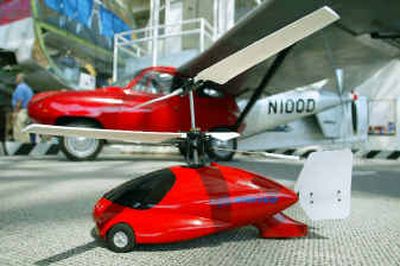Beyond the ‘Jetsons’

SEATTLE — It’s a frustrated commuter’s escapist fantasy: literally lifting your car out of a clogged highway and soaring through the skies, landing just in time to motor into your driveway.
Researchers stress that the ultimate dream — an affordable, easy-to-use vehicle that could allow regular people to fly 200 miles to a meeting and also drive 15 miles to the mall — is still probably decades away.
But engineers at NASA, Boeing Co. and elsewhere say the basis for a flying car is there. People have been building, or trying to build, such vehicles for decades.
The problem is, those ideas have generally required both a lot of money and the skills of a trained pilot. And melding cars and planes hasn’t always been very successful.
“When you try to combine them you get the worst of both worlds: a very heavy, slow, expensive vehicle that’s hard to use,” said Mark Moore, who heads the personal air vehicle division of the vehicle systems program at NASA’s Langley Research Center in Hampton, Va.
The goal isn’t just to create a neat gizmo: These vehicles will become more appealing — and necessary — as highways and airport hubs grow more clogged, and commutes more distant.
At NASA, the first goal is to transform small airplane travel. Right now, really small airplanes are generally costly, uncomfortable and loud and require months of training and lots of money to operate; that makes flying to work impractical for most people.
Within five years, NASA researchers hope to develop technology for a small airplane that can fly out of regional airports, costs less than $100,000, is as quiet as a motorcycle and as simple to operate as a car. Although it wouldn’t have any road-driving capabilities, it would give regular people the ability to fly short distances.
To make flying simpler, NASA is working on technologies that would automate more pilot’s functions.
In 10 years, NASA hopes to have created technology for going door-to-door. These still wouldn’t be full-fledged flying cars — instead, they’d be small planes that can drive very short distances on side streets, after landing at a nearby airport.
In 15 years, they hope to have the technology for larger vehicles, seating as many as four passengers, and the ability to make vertical takeoffs.
It will probably take years after these technologies are developed before such vehicles are actually on the market. And Moore says it will take about 25 years to get to anything “remotely ‘Jetsons’-like,”’ a reference to the futuristic cartoon that fed many flying car fantasies.
Researchers at Boeing in Seattle are already thinking that far ahead: They’ve created a miniature model of a sporty red helicopter/car hybrid that is helping the aerospace giant understand what it would take to make flying cars a reality.
Lynne Wenberg, senior manager on the project, said the goal is to make a flying car that costs the same as a luxury vehicle, is quiet and fuel-efficient and easy to fly and maintain.
Boeing is especially interested in the broader problem of figuring out how to police the airways — and prevent total pandemonium — if thousands of flying cars enter the skies. No one wants to be cut off, tailgated or buzzed a little too closely by a student driver at 1,000 feet.